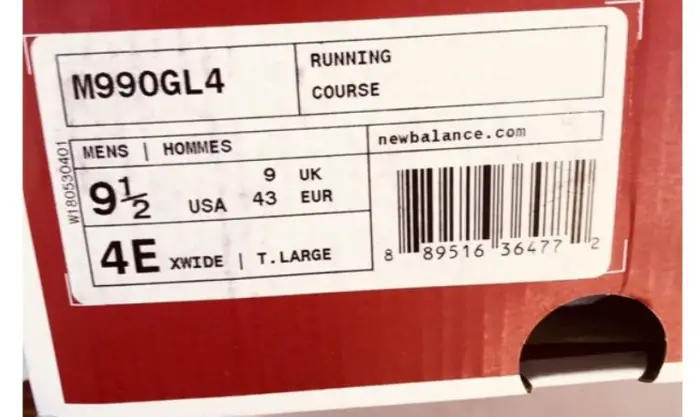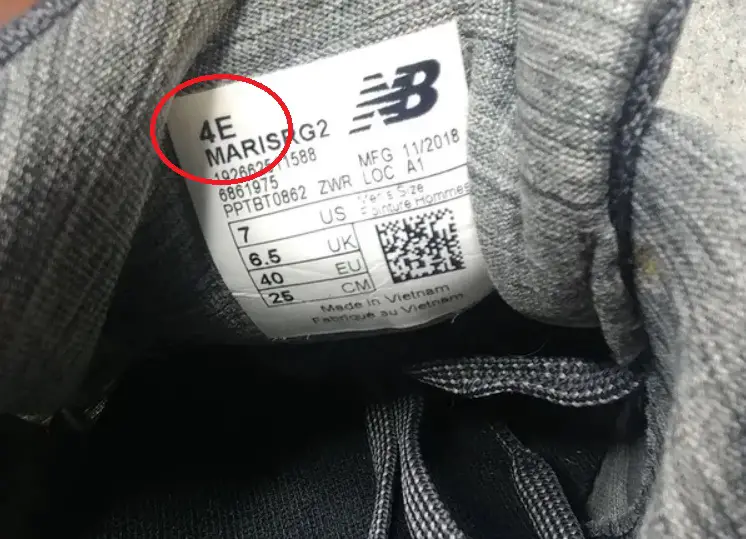Blog
What Does 4E Mean In Shoes?
Regarding shoe sizes, the width might sometimes cause so much confusion because common customers mostly only care about foot length.
So, what does 4E mean in shoes, as well as the tags looking so similar to it? Who needs to pay attention to them and who needs to avoid them?
This article is the easy answer to your questions!
Contents
What Does 4E Mean In Shoes?
The E letter in shoe widths stands for a wider fit than usual, and the most common indicators we will run into are 2E and 4E.
For men, 4E means extra wide shoes, hence it is rarely seen in women’s footwear.
Here are other common letters used in shoe widths:
- A/2A/4A
If you often purchase women’s shoes, the A tags would be quite common for you. It indicates a narrow fit for women and an extra narrow fit for men.
The more A’s, the narrower the shoes.
- B
For women, the B width is the most popular. It refers to normal, medium, and standard widths – all of them have the same meaning.
B means a narrow fit for men.
- D
Like B, D is the most regular width for men, and it has similar meanings. However, it is a wide fit for women.
- 2/2E/4E
The letter E means a wide fit for both genders. The more E you add, the wider the shoes are.
You might encounter widths as wide as 10E or beyond, which are only seen in shoes for diabetic patients.

How Wide Is 4E In Inches & Cm?
The standard chart for shoe sizes and corresponding widths in the 4E range is as below. We put 4E shoe widths in inches and centimeters for your convenience!
Men’s shoe 4E width chart
| US Men’s
Standard Size |
US Men’s Extra Wide (4E) | |
| cm | inches | |
| 6.0 | 10.95 | 4.31” |
| 6.5 | 11.11 | 4.37” |
| 7.0 | 11.27 | 4.44” |
| 7.5 | 11.43 | 4.50” |
| 8.0 | 11.59 | 4.56” |
| 8.5 | 11.75 | 4.63” |
| 9.0 | 11.91 | 4.69” |
| 9.5 | 12.07 | 4.75” |
| 10.0 | 12.22 | 4.81” |
| 10.5 | 12.38 | 4.87” |
| 11.0 | 12.54 | 4.94” |
| 11.5 | 12.70 | 5.00” |
| 12.0 | 12.86 | 5.06” |
| 12.5 | 13.02 | 5.13” |
| 13.0 | 13.18 | 5.19” |
| 13.5 | 13.34 | 5.25” |
| 14.0 | 13.49 | 5.31” |
| 14.5 | 13.65 | 5.37” |
| 15.0 | 13.81 | 5.44” |
| 15.5 | 13.97 | 5.50” |
| 16.0 | 14.13 | 5.56” |
| 16.5 | 14.29 | 5.63” |
| 17.0 | 14.45 | 5.69” |
| 17.5 | 14.61 | 5.75” |
Women’s shoe 4E width chart
| US Women’s Standard Size | US Women’s Extra Wide (4E) | |
| cm | inches | |
| 5.0 | 9.84 | 3.87” |
| 5.5 | 10.00 | 3.94” |
| 6.0 | 10.16 | 4.00” |
| 6.5 | 10.32 | 4.06” |
| 7.0 | 10.48 | 4.13” |
| 7.5 | 10.64 | 4.19” |
| 8.0 | 10.80 | 4.25” |
| 8.5 | 10.95 | 4.31” |
| 9.0 | 11.11 | 4.37” |
| 9.5 | 11.27 | 4.44” |
| 10.0 | 11.43 | 4.50” |
| 10.5 | 11.59 | 4.56” |
| 11.0 | 11.75 | 4.63” |
| 11.5 | 11.91 | 4.69” |
| 12.0 | 12.07 | 4.75” |
| 12.5 | 12.22 | 4.81” |
| 13.0 | 12.38 | 4.87” |
When Do You Need Wide Shoes?
If you find the length of a shoe perfectly fitting for your foot yet the sides feel crampy, it is a very clear sign that you need wider footwear.
Being stubborn and sticking to narrow shoes will result in excessive sweating first. With an unhealthy environment, more problems will follow suit: bunions, hammertoes, cramps, injections, and deformations.
However, when you wear overly loose shoes, your feet won’t stay in a fixed position.
Therefore, they will be rubbing against the insides of the shoes and causing blisters. If you wear them for hours, soreness is inevitable.
Check more: How To Dry Shoes After Washing Without Damaging Them?
How To Measure Shoe Width?
Finding your shoe width comes along with measuring the overall size accurately, hence the process follows the basic procedure:
- Stand straight against a wall and on a flat surface. If you plan to wear socks regularly, you can keep them on for a more compatible measurement.
- Tuck a large piece of paper under your foot and draw its shape as accurately as you can.
- Mark the two spots forming the widest part of your foot and measure this distance.
- Refer to the size chart of the brand you are buying from and choose your size.
Your foot width might change, hence a retake of your measurement is necessary from time to time. Health conditions, natural aging, and states such as pregnancy or weight changes can also affect your size.
In other cases, you might have worn medium footwear for so long it stretched and lost the original shape, which means you should get a wider fit if you want to feel comfortable from the beginning.
Extra Sizing Tips
Once your measurement is taken correctly, you will need these extra tips to ensure the fit you pick is as perfect as possible.
- Measure your feet in the evening or after an intense practice, when they are swollen and thus the biggest size possible. And yes, you need to measure both of them.
- If you have in-between measurements, choose the larger size. You can adjust it with socks, insoles, or even the lacing system of your shoes. Meanwhile, a narrow fit would be much more difficult to deal with.
- You should try both shoes on and take a walk to be sure the fit is snug but not too tight.
- You mustn’t feel cramped on the heels and the toes, or you will get blisters and calluses in the long run.
- Avoid testing your shoes outdoors or they might not be eligible for warranties anymore.
FAQs
1. What is the difference between 4E and 2E?
Since they both come from the E category of food widths, the difference between them is noticeable yet not remarkable. If you get a ruler and measure each of them, the gap is only half an inch.
You will see this difference most prominently across the ball of your feet, which also defines your foot width.
2. How much wider is 4E than D?
There is a half-an-inch difference between D and 2E as well as 2E and 4E. Thus, the difference can accumulate to a whole inch if we compare 4E and D, with 4E being the larger one.
Final Words
4E in shoes means a wider fit than normal. The 4E meaning shoes that are extra wide for men is rarely present for women’s footwear due to the signature difference between the fit of each gender.
However, we should always ensure the width and the length of our shoes combine well for a great fit, for a wrong size will lead to a lot of unwanted issues and possible injuries.

